The Invisible Line
Read The Invisible Line Online
Authors: Daniel J. Sharfstein

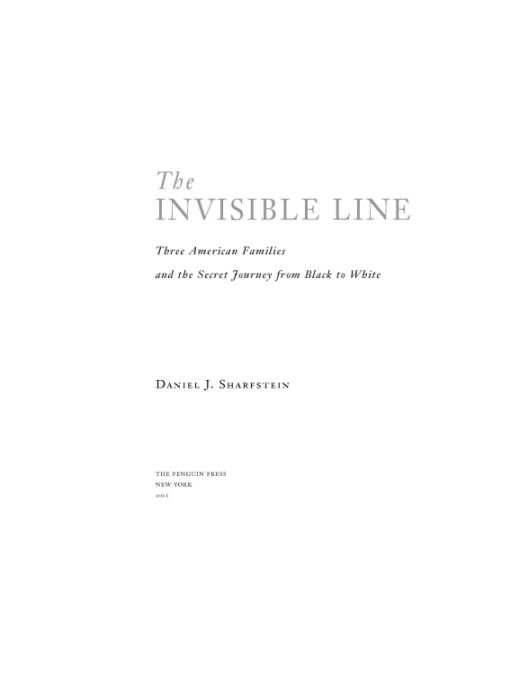
Table of Contents
Â
Â
Â
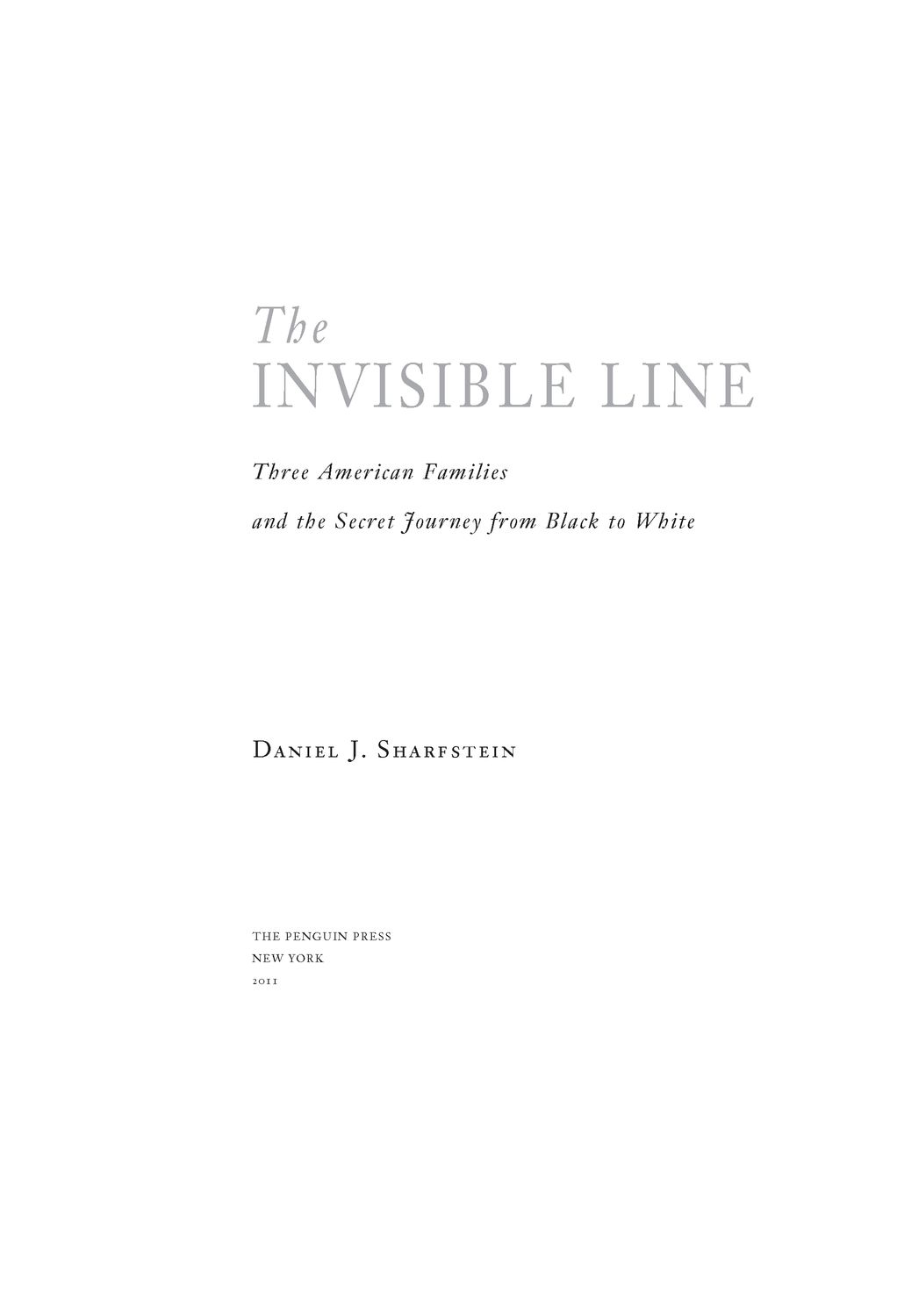
THE PENGUIN PRESS
Published by the Penguin Group
Penguin Group (USA) Inc., 375 Hudson Street, New York, New York 10014, U.S.A. ⢠Penguin Group (Canada), 90 Eglinton Avenue East, Suite 700, Toronto, Ontario, Canada M4P 2Y3 (a division of Pearson Penguin Canada Inc.) ⢠Penguin Books Ltd, 80 Strand, London WC2R 0RL, England ⢠Penguin Ireland, 25 St. Stephen's Green, Dublin 2, Ireland (a division of Penguin Books Ltd) ⢠Penguin Group Australia Ltd, 250 Camberwell Road, Camberwell, Victoria 3124, Australia (a division of Pearson Australia Group Pty Ltd) ⢠Penguin Books India Pvt Ltd, 11 Community Centre, Panchsheel Park, New Delhi-110 017, India ⢠Penguin Group (NZ), 67 Apollo Drive, Rosedale, North Shore 0632, New Zealand (a division of Pearson New Zealand Ltd) ⢠Penguin Books (South Africa) (Pty) Ltd, 24 Sturdee Avenue, Rosebank, Johannesburg 2196, South Africa
Â
Penguin Books Ltd, Registered Offices:
80 Strand, London WC2R 0RL, England
Â
First published in 2011 by The Penguin Press,
a member of Penguin Group (USA) Inc.
Â
Copyright © Daniel J. Sharfstein, 2011 All rights reservedÂ
Library of Congress Cataloging-in-Publication Data
Â
Sharfstein, Daniel J.
The invisible line : three American families and the secret journey from Black to white / Daniel J.
Sharfstein
p. cm.
Includes bibliographical references and index.
eISBN : 978-1-101-47580-5
1. Racially mixed peopleâRace identityâUnited StatesâCase studies. 2. MiscegenationâSocial aspectsâUnited StatesâCase studies. 3. Passing (Identity)âUnited StatesâCase studies. 4. RaceâSocial aspectsâUnited StatesâCase studies. 5. Race awarenessâUnited StatesâCase studies. 6. United StatesâRace relationsâCase studies. 7. Gibson family 8. Spencer family. 9. Wall family. I. Title.
E184.A1S5724 2011
305.800973âdc21
2010029647
Â
Â
Â
Without limiting the rights under copyright reserved above, no part of this publication may be reproduced, stored in or introduced into a retrieval system, or transmitted, in any form or by any means (electronic, mechanical, photocopying, recording, or otherwise), without the prior written permission of both the copyright owner and the above publisher of this book.
Â
The scanning, uploading, and distribution of this book via the Internet or via any other means without the permission of the publisher is illegal and punishable by law. Please purchase only authorized electronic editions and do not participate in or encourage electronic piracy of copyrightable materials. Your support of the author's rights is appreciated.
For Ann
AUTHOR'S NOTE
The Invisible Line
is a work of history. It tells the stories of real people who left traces of their lives in census and military records, wills and property deeds, the occasional memoir, and stories in the back pages of newspapers. In the course of my research, I drew upon the resources of courthouses, manuscript libraries, government archives, and private collections in eighteen states and the District of Columbia. I found that I was able to reconstruct the lives and worlds of the book's main figures in considerable detailâtheir neighborhoods down to the siding on the homes, the day-to-day routines of their jobs, even the size of the collars they wore on their shirts. Above all, their individual characters emerged with remarkable clarity in private letters, newspaper interviews, and testimony in court and before Congress.
is a work of history. It tells the stories of real people who left traces of their lives in census and military records, wills and property deeds, the occasional memoir, and stories in the back pages of newspapers. In the course of my research, I drew upon the resources of courthouses, manuscript libraries, government archives, and private collections in eighteen states and the District of Columbia. I found that I was able to reconstruct the lives and worlds of the book's main figures in considerable detailâtheir neighborhoods down to the siding on the homes, the day-to-day routines of their jobs, even the size of the collars they wore on their shirts. Above all, their individual characters emerged with remarkable clarity in private letters, newspaper interviews, and testimony in court and before Congress.
Many of the people I chronicle left behind a voluminous record of their thoughts, aspirations, and agonies. To convey the richness of their stories, I have written the book from their perspectives whenever possible. I have set scenes and described individuals and places as clearly and vividly as the sources allow, consistent with what I know about the time, locations, people, and events. Often the descriptions are based on letters, interviews, and court testimony. In the absence of these personal expressions, I have relied on other material, including documented sources from contemporaneous observers, local histories, and my own observations. Like every historian, I have made inferences in interpreting primary sources, but these inferencesâmy interpretations of historyâare always rooted in fact.
Because
The Invisible Line
is a history of race told largely from the perspective of people who lived in the eighteenth, nineteenth, and early twentieth centuries, I have made every effort to preserve their individual voices by retaining the original spelling, capitalization, and punctuation in direct quotations. I also use a number of archaic terms to refer to African Americans. These are the terms that the subjects of this book used in order to think about racial categories and to define themselves and others.
The Invisible Line
is a history of race told largely from the perspective of people who lived in the eighteenth, nineteenth, and early twentieth centuries, I have made every effort to preserve their individual voices by retaining the original spelling, capitalization, and punctuation in direct quotations. I also use a number of archaic terms to refer to African Americans. These are the terms that the subjects of this book used in order to think about racial categories and to define themselves and others.
“Now measure ten drops into the paint ... There, that's it, not too goddam fast. Now. You want no more than ten, and no less.”
Slowly, I measured the glistening black drops, seeing them settle upon the surface and become blacker still, spreading suddenly out to the edges.
“That's it. That's all you have to do,” he said. “Never mind how it looks. That's my worry. You just do what you're told and don't try to think about it. When you've done five or six buckets, come back and see if the samples are dry . . . And hurry, we've got to get this batch back off to Washington by 11:30 . . .
“Let's see,” he said, selecting a sample and running his thumb across the board. “That's it, as white as George Washington's Sunday-go-to-meetin' wig and as sound as the all-mighty dollar! That's paint!” he said proudly. “That's paint that'll cover just about anything!”
He looked as though I had expressed a doubt and I hurried to say, “It's certainly white all right.”
“White! It's the purest white that can be found. Nobody makes a paint any whiter. This batch right here is heading for a national monument!”
RALPH ELLISON,
Invisible Man
(1952)
Invisible Man
(1952)
Â
“Where is the blood of me? Where is my color? My blood is covered over the cornfield among these hills ... Blood and sweat of mine is on the bare hills where they ain't no timberâwhere there is old corn rows. That's where my blood is and my color is.”
JESSE STUART, “Battle Keaton Dies,” in
Head o' W-Hollow
(1936)
Head o' W-Hollow
(1936)
WALL FAMILY TREE
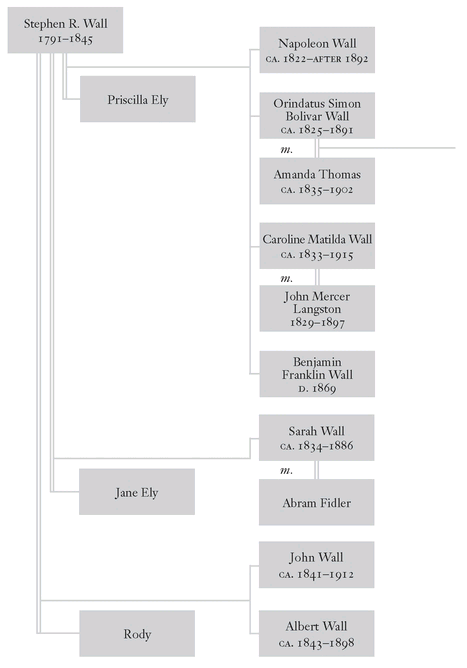
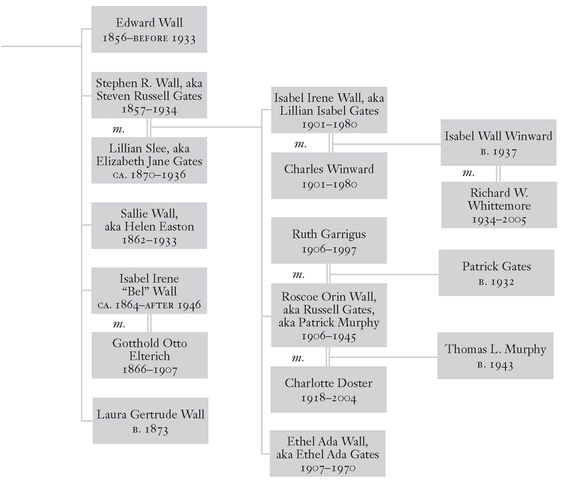
For reasons of space and clarity, the family trees depict only those branches that are featured in this book. Each family can claim dozensâeven hundredsâof living descendants.
SPENCER FAMILY TREE
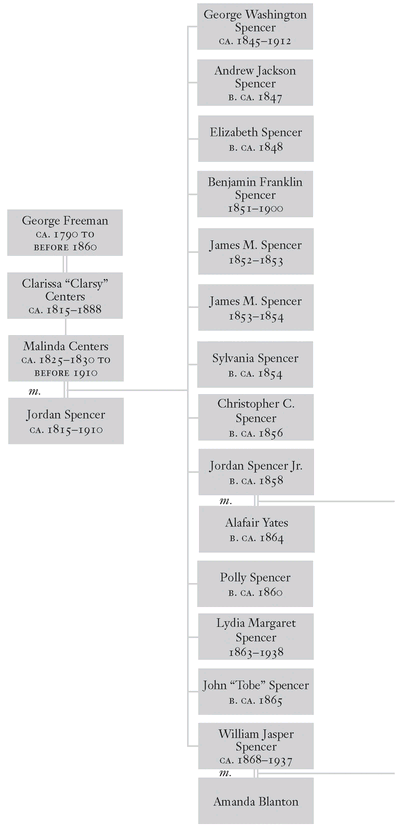
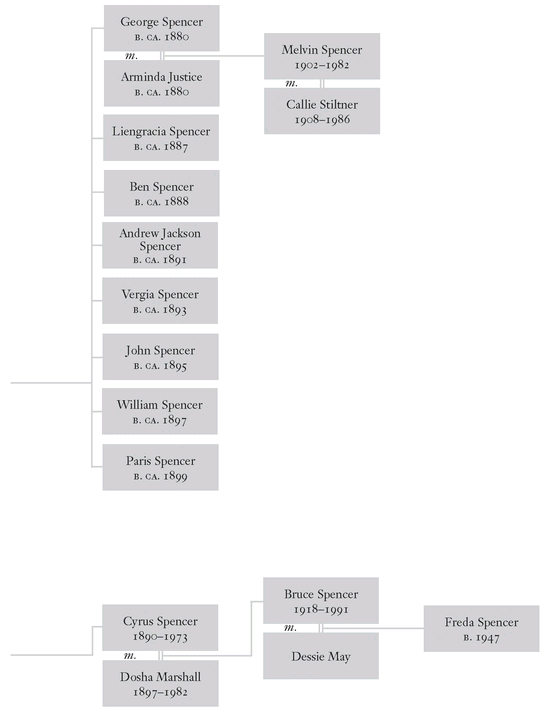
Other books
The Sweetheart Racket by Cheryl Ann Smith
The Dark Secret of Weatherend by John Bellairs
Flamingo Blues by Sharon Kleve
Ghost of the Thames by May McGoldrick
Furever Yours by Catherine Vale
Total Control by Desiree Wilder
Gith by Else, Chris
Stolen Dreams by Terri Reid
The Metal Maiden Collection by Piers Anthony
Negotiating Point by Adrienne Giordano
